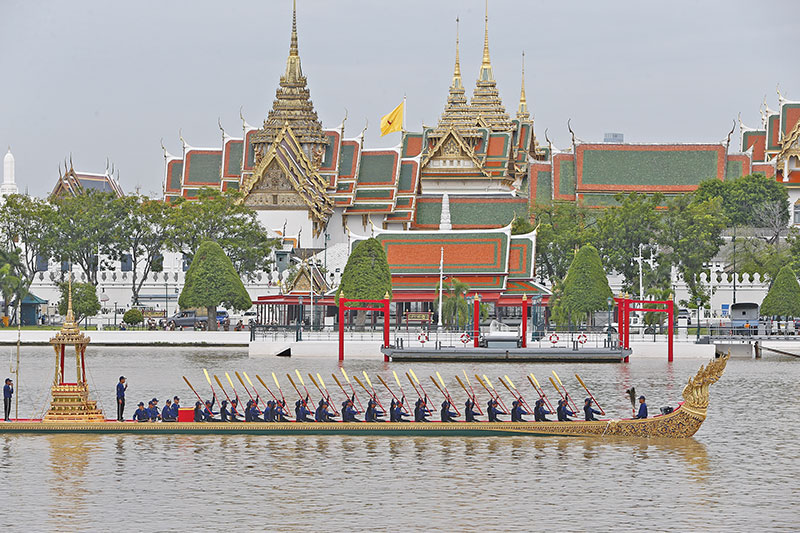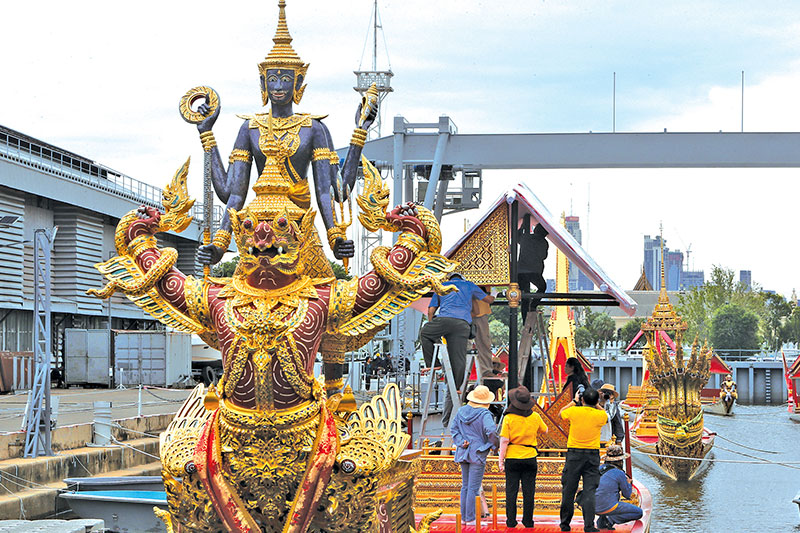
River Rhapsody
Thailand’s heritage takes centre stage in the rare and dazzling spectacle of the Royal Barge Procession
Words: Sarita Urupongsa
Thailand is preparing to host one of its most spectacular ceremonies – the Royal Barge Procession. This awe-inspiring event, steeped in centuries of tradition, is a grand display of the kingdom’s deep connection to its monarchy, religion, and cultural heritage.
The royal procession’s return to the Chao Phraya River promises to captivate Thais and international visitors alike, offering a rare glimpse of the grandeur of Thai royal rituals. This year, His Majesty the King will preside over the river journey to present Kathin robes at Bangkok’s Temple of Dawn.
The Royal Barge Procession was first held in times of both war and peace. Originally, the barges served practical purposes, transporting troops, goods, and even the royal family. Over time, this evolved into a ceremonial procession, symbolising the divine status of the Thai monarch as a protector and unifier of the nation.
The procession, as we know it today, was further refined during the Rattanakosin period (1782-1932), particularly under the reign of King Rama I. The event’s symbolism was solidified, and it became an integral part of important royal and religious ceremonies, including the coronation of new kings, royal weddings, and the annual Kathin ceremony, where monks are presented with new robes.
This year, the procession will feature an impressive fleet of 52 intricately decorated barges, each a masterpiece of traditional Thai craftsmanship. Floating works of art, the barges are adorned with gold leaf, lacquer, and ornate mosaic. They represent different deities, mythical creatures, and animals from Hindu and Buddhist cosmology, reflecting Thailand’s deep spiritual roots.
At the heart of the flotilla is the Suphannahong, the king’s personal barge. This majestic vessel, shaped like a mythical swan, is considered the most important and revered vessel in the fleet. A symbol of the king’s divine authority, it is reserved exclusively for the reigning monarch. The Suphannahong is followed by the Anantanakkharat barge, featuring a seven-headed Naga serpent that symbolises the king’s power and protection.
Each barge has its own unique design and significance, such as the Anekchatphuchong, which carries the royal regalia and offerings, and the Narai Song Suban, depicting the Hindu god Vishnu riding the Garuda, symbolising the king as a divine ruler.
The Royal Barge Procession is a meticulously choreographed event, involving over 2,200 oarsmen specially trained for this prestigious occasion. Dressed in traditional costumes, the oarsmen row in perfect unison, their synchronised movements reflecting the precision and discipline required for such as grand spectacle. The procession moves gracefully along the Chao Phraya River, accompanied by the rhythmic chanting of ancient hymns and the music of traditional Thai instruments.
Each procession holds special significance as it marks the continuation of a living tradition carefully preserved and passed down through generations. The ceremony is not only a celebration of the monarchy but also a reflection of Thailand’s national identity. It serves as a reminder of the country’s rich cultural heritage and the enduring bond between the Thai people and their king.
The procession will begin at the Wasukri royal pier and proceed down the Chao Phraya River, passing by some of Bangkok’s most iconic landmarks, including the Grand Palace and the Temple of the Emerald Buddha. The final destination is the Temple of Dawn (Wat Arun), where the king will present offerings to monks during the Kathin ceremony.
For spectators, the Royal Barge Procession offers a unique opportunity to witness a living tradition rarely seen in modern times. The event is expected to draw thousands of onlookers to the riverbank, eager to catch a glimpse of the royal barges and the king himself.
For those fortunate enough to witness it, the Royal Barge Procession is an unforgettable experience – a living link to Thailand’s glorious past and a shining beacon of its enduring legacy.
The Royal Barge Procession takes place on October 27 from 3-6pm. Designated public viewing areas will be opened along both sides of the Chao Phraya River, from the Rama VIII Bridge to the Temple of Dawn (Wat Arun), Bangkok.

A Brief History of Thailand’s Royal Barges
Origin: The tradition of royal barges dates back to the Ayutthaya Kingdom (1350-1767). Originally used for war and transport, these vessels gradually became a symbol of royal power and religious devotion.
Rattanakosin Era: King Rama I (1737-1809) revived the tradition in the early Rattanakosin period, establishing a grand fleet for ceremonial purposes. The most significant ceremony is the Royal Barge Procession, held during major celebrations and Buddhist rituals.
The Fleet: The procession features over 50 vessels, manned by thousands of oarsmen. The highlight is the Suphannahong (Golden Swan), the king’s personal barge, carved from a single piece of teak and adorned with intricate gold and glass mosaics.
Modern Era: The barges are preserved and displayed at the Royal Barge National Museum in Bangkok when not in use. They continue to play a vital role in Thai cultural heritage, showcasing the craftmanship and artistry of Thai shipbuilders.
